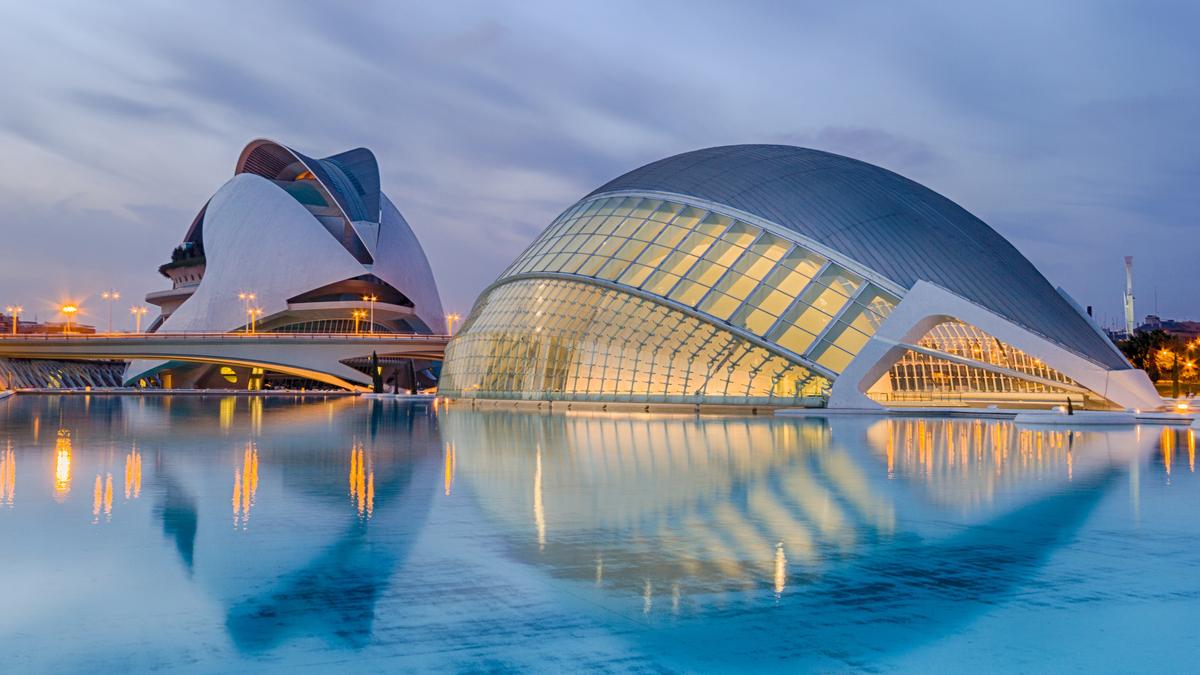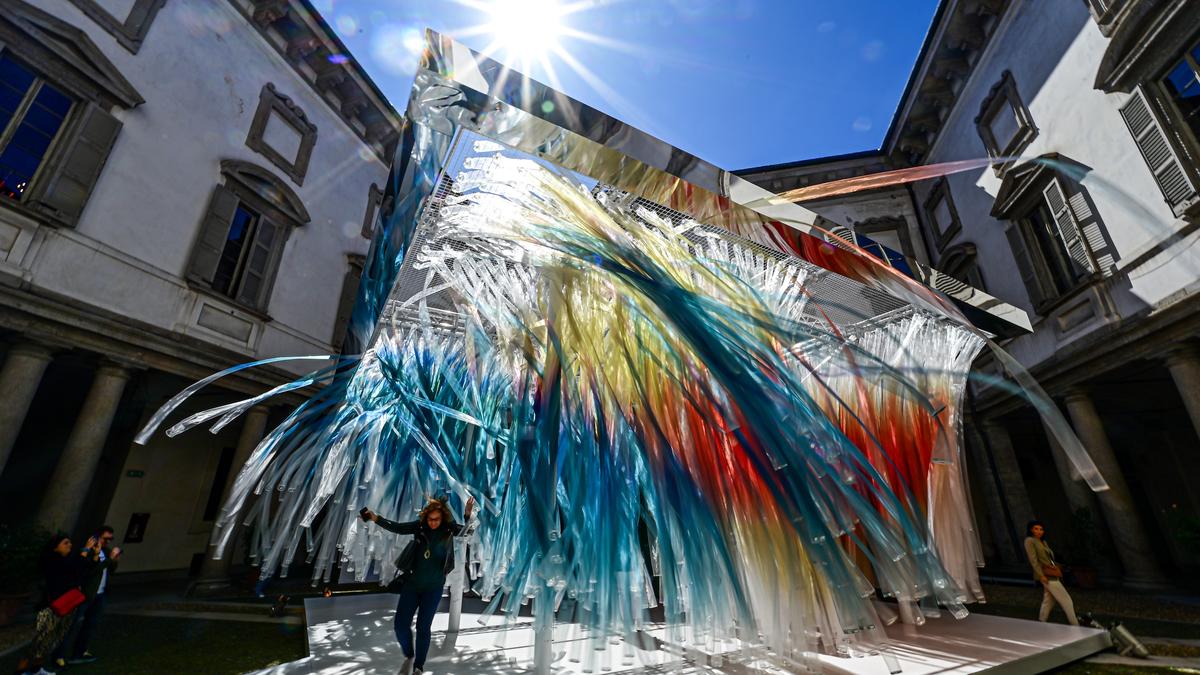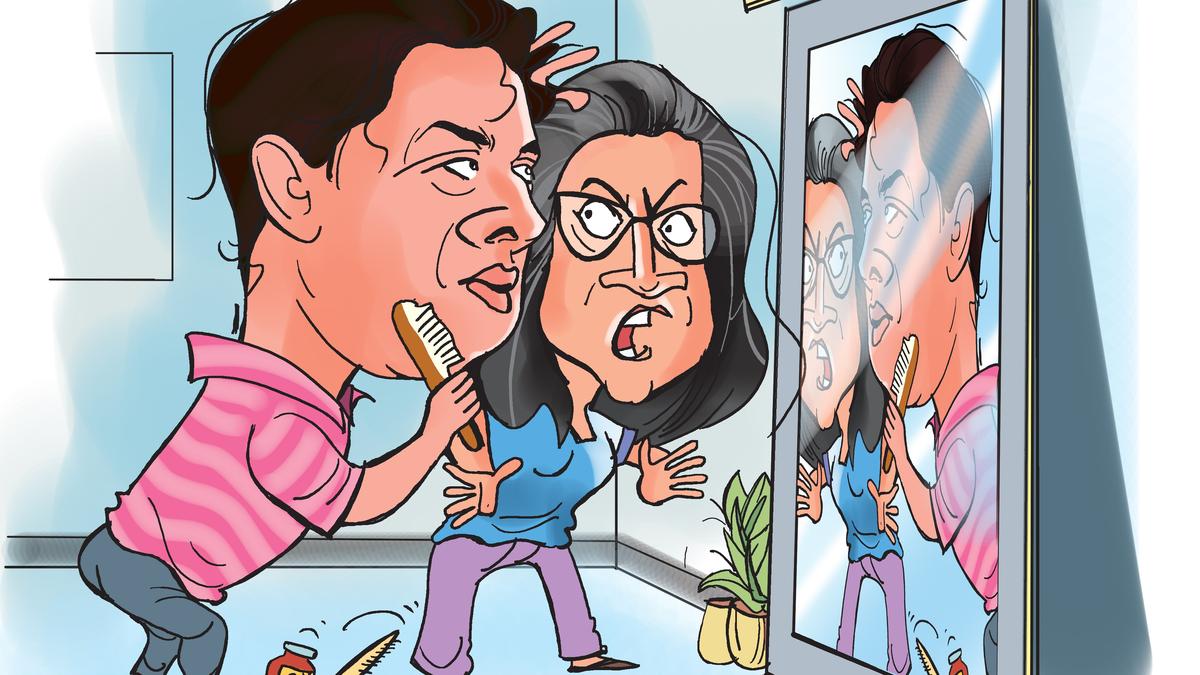
Ecofeminist art, or the intersection of feminism, politics, ecology and art, has expanded in scope and themes
Sudipta Das has witnessed drastic ecological changes over the years in her hometown of Silchar in Assam. “These days, we are getting excessive rainfall during what are supposed to be dry months. Nature is disturbed. Floods arrive earlier than usual, and with greater ferocity,” says the 39-year-old artist, who is currently based out of Vadodara, Gujarat.
Das has witnessed a disproportionate impact of these natural calamities on women in Silchar. It is the women of the household who flush out the water from homes, arrange for food, and take care of the farmlands. “They end up falling ill the most during this time,” says Das, who is known for her figurines, crafted from rice paper and Hanji paper, depicting the migration of communities due to political and geological changes. Deeply touched by the suffering of women during natural upheavals, the artist—who calls herself an ecofeminist—has been creating works for the series, Mother and Child.
Ecofeminism—the intersection of feminism, politics and ecology—isn’t a new term. It was first coined by French writer Francoise d’Eaubonne in her 1974 book, Le Féminisme ou la Mort. She wrote: “Ecofeminism relates the oppression and domination of all marginalised groups (women, people of color, children, the poor) to the oppression and domination of nature (animals, land, water, air, etc.).”
As the world goes through drastic ecological changes, the concept of ecofeminism has acquired greater urgency. “The climate crisis is not ‘gender neutral’,” states a report, dated 28 February 2022, on the UN Women website. “Women and girls experience the greatest impacts of climate change, which amplifies existing gender inequalities and poses unique threats to their livelihoods, health, and safety. Across the world, women depend more on, yet have less access to, natural resources.”
Taking art to its roots
Art too has been responding to the concept of ecofeminism since the 1970s. A landmark 2020 exhibition, ecofeminism (s) —curated by Monika Fabijanska, an art historian who specialises in women’s and feminist art at the Thomas Erben Gallery in New York—offered a historical perspective of this genre of art, and its relevance today. The curatorial note stated that “ecofeminism is one of the richest hidden caches of contemporary art. It is art that delights the eye, provokes the mind, and can inspire change. It also restores art’s function to what it was before the Enlightenment, when both science and art were tools to understand the world and propose solutions.”
The exhibition looked at the works of pioneering artists such as Betsy Damon, Ana Mendieta, Aviva Rahmani and Cecilia Vicuña, “and how their ideas and strategies are continued, developed or opposed by the young generation”. In India too, over the past few decades, contemporary artists such as Vibha Galhotra, Sonia Mehra Chawla, Navjot Altaf and Rohini Devasher have consistently been responding to political and environmental ecologies, but without really defining themselves as ecofeminists.
However, there has been a change in the way artists are now excavating complex relationships between gender, ecology, capitalism, oppression, and more. The scope has expanded to include queer histories, anti-nuclear war sentiments, and privatisation of land resources. The mediums too have moved beyond painting and sculpture to include performance art and multimedia, with the body playing an integral role in the work. Bhavna Kakar, founder, Gallery Latitude 28, Delhi—who represents ecofeminist artists such as Das and Manjot Kaur— feels that this genre of art plays, now more than ever, a pivotal role in amplifying suppressed voices, evoking empathy, and inspiring action towards collective responsibility to nurture and protect our ecosystem for future generations.

Sudipta Das, ‘The Family’, (2023). Photo: courtesy Latitude 28
2023 witnessed some of the highest temperatures on earth, and many countries around the world grappled with extreme weather conditions. It is no wonder then that the past two years have seen a rise in the number of exhibitions focusing on ecofeminist art as well in response to these changes. For instance, the Tai Kwun Contemporary in Hong Kong presented Green Snake: Women-Centred Ecologies, between 20 December 2023 and 1 April 2024.
Curated by Paris-based artist historian and writer Kathryn Weir and Xue Tan, a writer-producer from Hong Kong, the show explored mythology, feminism and ecology in the context of accelerating extreme weather events, and presented works by more than 30 artists and collectives from 20 countries. “Rather than unfolding a bleak, dystopian view, Green Snake asks what alternative narratives are activated through artists’ visions that celebrate nature as an all-encompassing and generative force—many of them grounded in notions of care and interrelationship that are central to ecofeminism,” stated the exhibition note.
New visual stories
Manjot Kaur was one of the Indian artists, whose work was displayed at Tai Kwun Contemporary. Using miniature painting traditions with contemporary themes, the artist combined ancient stories and precarious ecologies with “speculative visions of alternative relationships between deities, humans and the environment”.
According to Kakar, Kaur’s work transcends the traditional confines of gender and nature by exploring new visual stories that provide us with alternative routes to “un-civilise” from the masculine capitalist culture. “In her series, Ecosystems are Love Stories, Manjot’s visual narratives intertwine the sovereignty of ecologies with the autonomy of women’s bodies, challenging established power dynamics,” she explains. “…[the artist] underscores the symbiotic relationship between motherhood, ecology, and resistance to oppressive structures, inviting viewers into a dialogue on power, agency, and the fluid boundaries between human and non-human realms.”
Changing vocabulary
The 2024 edition of Colomboscope, which opened in Colombo in January, also looked at ecofeminist art in a big way. Co-curated by Sheelasha Rajbhandari, Hit Man Gurung and Sarker Protick, with Natasha Ginwala as the artistic director, the event had many artist-led conversations on the theme. One such discussion, Ecofeminist kin, featuring Cecilia Moo, Emma Nzioka, Eisa Jocson, Venuri Perera and Rajbhandari, looked at how ecofeminism has historically been practised through ceremonial offerings, indigenous activism, domestic and agricultural labour—and how artists have looked at this in their own way.
One got to see a work-in-progress performance, Magic Maids, by Perera and Jocson, who delved into the European history of witch-hunts and “their direct consequences to the exploitation of women’s labour, particularly domestic labour in the Global South, as well as narratives around persecution of migrant workers today,” states the curatorial note. The broom and the act of sweeping, then, became a symbol for the ongoing subjugation of migrant women workers. This performance stands as a fine example of the new language in ecofeminist art today.
The change in artistic vocabulary is evident in indigenous, or traditional, forms as well. While ecofeminism has been practiced in contemporary art since the 1970s, traditional themes have been rooted in nature since time immemorial. Artists from Gond, Madhubani, Bhil and Baiga traditions have commented on the interdependence of humanity and nature since the very genesis of art forms.

‘Burning of Bandhavgarh’ by Jodhaiya Bai Baiga. Image: courtesy Minhazz Majumdar
In fact, the changing weather conditions and their impact are more visible than ever in the art that comes from the grassroots. Take, for instance, Burning of Bandhavgarh, an acrylic on canvas by artist Jodhaiya Bai Baiga, based out of Umaria district in Madhya Pradesh, which commented on the rising number of forest fires in the region. It was shown in 2022 as part of the exhibition of indigenous art, Bhumijan: Artists of the Earth, presented by the Crites Collection at the Visual Arts Gallery in New Delhi. “For women from traditional communities, who have limited agency and voice, art is becoming a powerful tool to make themselves heard,” says Minhazz Majumdar, a Delhi-based writer, designer and curator specialising in Indian traditional arts, who also curated the Bhumijan show. “A lot of them can’t vocalise their concerns due to societal pressures, but can communicate them through the non-verbal language of art.”
Pushpa Kumari, who is based out of Ranti, Bihar, and Delhi and practises the Madhubani art tradition, was the only Indian artist to be invited to the 23rd Sydney Biennale in 2022. She consciously looks at feminist themes, relevant to the 21st century, within ecology. Her 15ft-long work, Ganga Maiya (2021), shows the hypocrisy of society in deifying a river as a mother goddess, while having no qualms about dumping garbage and industrial waste in her waters. Sonia Chitrakar, a young artist from Bengal, who specialises in patachitra—an art form traditionally practised by men—has addressed natural calamities such as the tsunami, Bhuj earthquake, the covid-19 pandemic, and their impact on women and children, through her works.
Then there is Ramrati Bai, who like Jodhaiya Bai, is based in Umaria, Madhya Pradesh and hails from the Baiga tribe. She is not only a painter but also an accomplished dancer—as she performs with her husband, the couple go into a trance, becoming a vessel for the divine. “The Baigas are a displaced tribal community, who were once forest dwellers and now live on the margins of society,’ says Majumdar. “Ramrati Bai (born in 1979) paints memories of the enchanted forests of her childhood and what the Baiga life used to be like.” However, she brings a unique feminist touch to these reminisces. In her monumental work, The Dance of Devi Matas—measuring 22x6ft—she evokes the divine feminine in different avatars as worshipped by the Baigas. The work featured in the Roots show, earlier this year in Delhi, curated by Alka Pande and Mitchell Crites.
“She has fused two concepts dear to the Baigas in this work by giving each of the venerated mother goddesses a musical instrument,” writes Majumdar in a curatorial note about Ramrati Bai’s practice. “Traditionally, the goddesses are not associated with playing an instrument. Bai is very concerned about the younger generation of Baigas losing touch with their culture, with many of them moving faraway to work as migrant labourers and others, adopting modern life. By depicting the goddesses with traditional musical instruments such as the dafli, mandaar, timki, matka, veena and khanjniya, Bai hopes to commit to public memory the ways of her people.”
Her work then becomes an interesting lens to view the impact of urbanisation on the natural world and the communities that dwell within. The Baigas, for instance, have seen their language decline, and music and dance slowly recede from their life. “Part invocation and part lament, because the culture of the Baiga community is dying out due to migration and modernity, The Dance of the Devi Matas is an invocation, paradoxically for protection of and from the Mother Goddesses,” writes Majumdar.
Source | Powered by Yes Mom Hosting





